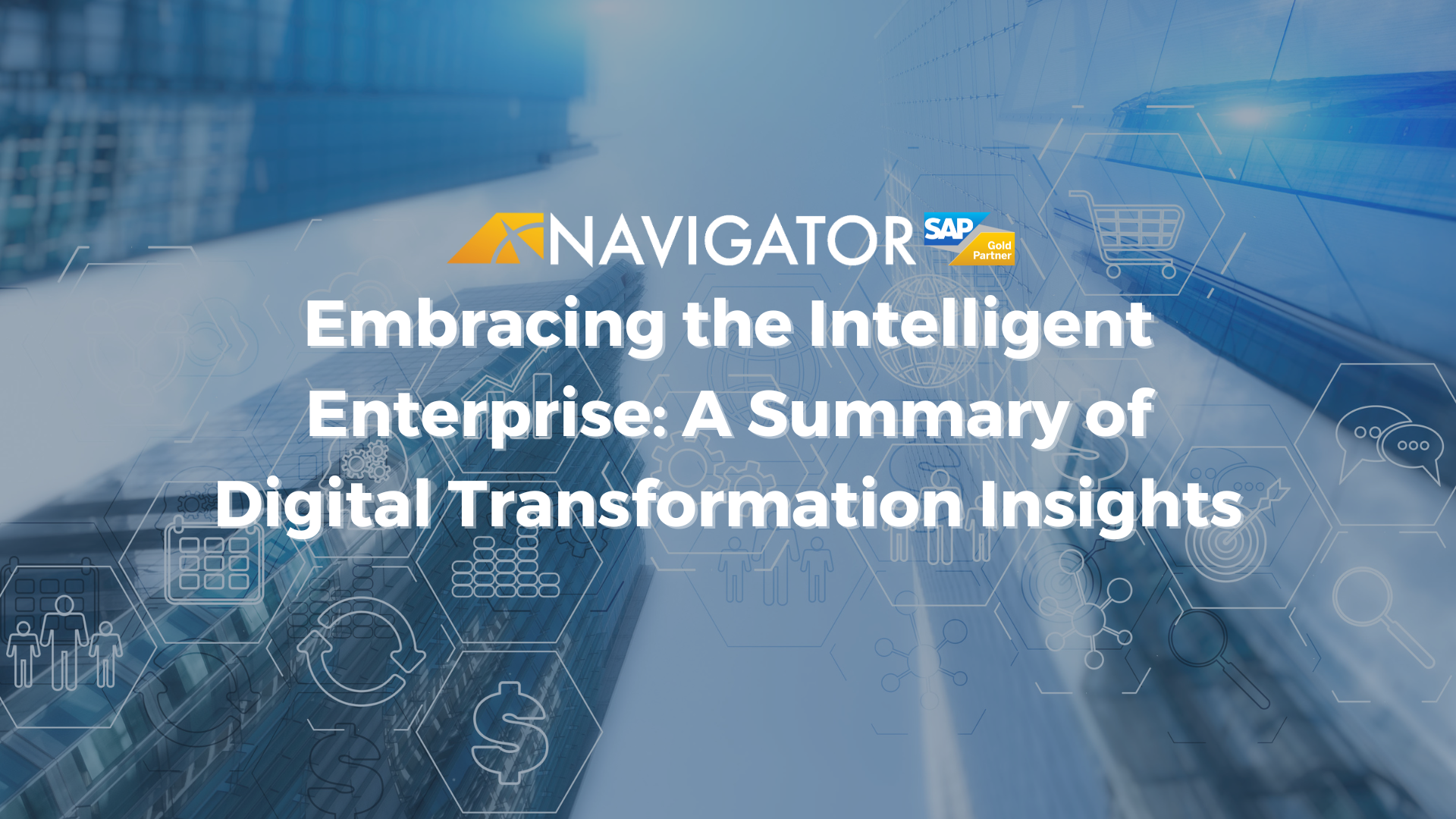HOW THE RIGHT CLOUD BASED ERP CAN GUIDE DIGITAL TRANSFORMATION
Preface
Small and mid-size suppliers to retailers and consumers have an advantage when it comes to competing with the larger players. Not yet burdened by the complexities and sheer volume faced by industry giants such as Amazon, the smaller operator can take advantage of their flexibility and rapid response to supply chain hiccups, environment changes, and relationship problems, or at least they should.
But Omni-Channel fulfillment has brought a once unimaginable complex environment characterized by digital disruption to the small and mid-sized marketplace. Retail, wholesale, and ecommerce channels have blended, and suppliers must ship from DCs, stores, and vendors while facilitating in-store pick-ups and accommodating returns from anywhere.
Retailers such as Home Depot and Kohls are seeing significant sales growth from the “click and collect channel,” and over 40 percent of the Home Depot’s online orders leverage physical stores. Moreover, Home Depot plans to further leverage its physical stores this year and roll out a "buy online, deliver from store" option as well. Kohl’s recently reached an agreement to take Amazon Returns and sell Amazon electronics.
Top retailers such as Apple, Best Buy, and Walmart are also responding to consumer demand to buy online and pick-up instore while, in 2015, Target invested $1 billion in strengthening its e-Commerce, which included everything from grocery delivery, to ship from store, and click and collect.
To leverage their nimbleness and compete on a global scale, smaller players need cost-effective and easily integrated tools to serve retailers and consumers and adapt to environmental change, specifically, digital disruption. In short, to remain relevant, suppliers must embrace digital transformation with agile solutions.
Digital transformation is different than just digitizing your documents. Without it, Omni-Channel fulfillment is not sustainable. Businesses must select the right cloud based ERP (enterprise resource planning) solutions to navigate the new e-Commerce, logistics, and payment ecosystem. While small and mid-size businesses are lithe, they cannot afford to invest in systems that are not similarly all-encompassing.
Adapting to today’s digital world is an ongoing effort to make the right choices in a timely way. Smaller players, particularly, need agile solutions that use business intelligence and real-time analytics for strategic decision making.
Management Summary
For complex Omni-Channel distribution, disruption in the supply chain is inevitable in an uncertain environment. ERP solutions must mitigate disruptions and minimize the financial impact. Today’s supply chains cross borders, and ERP software must be able to manage everything from consumer interfaces and inventory to multi-country and multi-currency financials.
The right decisions and choices can streamline logistics, warehousing, transportation, and e-Commerce so that sourcing delivery through to the last mile is a process that is constantly perfected and responsive to consumer demand. For example, for most retailers, in a B2B channel, the distribution center ships as many deliveries as there are stores. In a B2C channel, a truck might hold thousands of boxes, but each one holds only a few items.
A major challenge is increasing the number of deliveries while decreasing the number of line items in the system. Other challenges for distributors are running cross-channel activities with separate logistic operations. According to Intelligence AG, a French study conducted by CXP and Supply Chain magazine found that only 18 percent of companies have separated the two, and over 80 percent are pooled.
Picking the right processes and other operational decisions are crucial. Amazon has perfected its logistical process for receiving goods. Rather than sorting stock at warehouses before putting them away for later picking, incoming goods are put in the closest available bin so that they are immediately available.
There is a more complex sorting process later, but the process reduces stock levels in distribution centers and frees up cash. The right ERP solutions empower C-suite decision makers and IT professionals with better, real-time analytics. The information can stimulate innovative new processes that solve supply chain delays. Better deliveries encourage growth by meeting global, competitive, and technology pressures and defining new revenue streams and global new markets.
We look at three of the hotspots faced by suppliers in an environment where the digital world is disrupting distribution. We’ll explain how distributors and suppliers can manage their own digital transformation to keep their company forward-looking and competitive.
1 Are you anticipating the impact of digital transformation?
We now function in an omni-channel world. Retailers are experimenting with multi-channel marketing, sales, and orders and changes are rapidly occurring before their impact is fully understood.
Fulfillment is at the core of logistics and distribution, and the machinations of how fulfillment occurs represent the behind-the-scenes operations that must run smoothly.
As retailers are investing in transportation and warehousing and experimenting with new retail models such as home delivery, online to pop-up stores, and merchandise-less showrooms, the distributor with no business intelligence is struggling to respond to this evolving ecosystem.
2 Are data driving your business operations?
To make strategic decisions, retailers are leveraging big data and are more analytical than ever. Analytics allow them to understand their customer, and manufacturers and distributors must do the same. But many manufacturers ignore the opportunity to access data about the end customer. They rely on the retailer to guide them.
The end consumer is changing in rapid and demanding ways. As Amazon has realized, customers want fulfillment their way. They want to know the source market, where a product was made, the manufacturer’s practices. They want information and to get it, the fulfillment complexities of the supplier-retailer relationship compound.
ERP solutions use data to understand the customer, new retail experiences, fulfillment channels, and consumption patterns. Retailers respond to customer demand by offering different volumes and assortments of products all affecting the supply chain. There are new stores to ship to, new schedules, changes in inventories, logistics, and costs.
While consumers are interacting and obtaining their own product information from Facebook, Instagram, and Pinterest, customer data is collected as they increasingly order from Amazon and eBay for fast processing and free shipping. Sophisticated AI can transform the data into action and guide the retailers and distributors’ next steps.
Distributors must be partners in the logistics ecosystem, and that requires digital transformation. Using big data and the right solutions, retailers and distributors can partner, anticipate market movements and trends, and ensure the supply chain works, and the consumer is satisfied.
3 Is analytics your basis for better decisions?
It’s often a process of experimentation. Fulfillment is a space where retailers and suppliers are constantly analyzing processes, policies and financial issues. But the data are the drivers of change, and by plugging in and harvesting the data, fulfillment becomes easier.
But this state of confusion is where the smaller business, with the right ERP solutions, can take advantage. Often, smaller more frequent orders from warehouse to store are required, a drop-ship option, or stock in “sales ready” inventory. If the supplier can be more responsive to the retailer and the consumer, everybody wins. So, how do the data drive the technology for heightened response?
Tapping big data and using better analytics improves operational control. Omnichannel commerce used to require extensive back-office work to track inventory, manage shipping, and process returns. Small and mid-size businesses were hard-pressed to manage what was, ultimately, multiple businesses at the same time.
But technology has caught up, and growth is no longer sustainable from single-channel operations when the rest of the retail world has gone omnichannel. According to the BBC, Amazon is not hugely profitable although it is now worth $247 billion, but it remains afloat and the market leader despite tight margins with efficiency and making full use of AI and business intelligence in its fulfillment operations.
While consumers are interacting and obtaining their own product information from Facebook, Instagram, and Pinterest, customer data is collected as they increasingly order from Amazon and eBay for fast processing and free shipping. Sophisticated AI can transform the data into action and guide the retailers and distributors’ next steps.
SaaS e-Commerce solutions are driving the ability of merchants to use a single commerce platform for a holistic view of sales, inventory, fulfillment, and pricing. With an ERP platform, suppliers can be an effective and responsive part of the supply chain that retailers and consumers rely on.
Suppliers with strong business intelligence and analytics that provide real-time information are well-placed to establish and manage growth strategies in partnership with retailers by planning new product and service offerings and expanding into new markets.
4 Are you empowering your decision-makers with digital solutions?
In fact, growth depends on ERP. Global, competitive, and technology pressures are increasing as new business processes are constantly introduced to better manage companies, define new revenue streams, and break into global markets. Big data and analytics provide better visibility so that the right IT can build a competitive advantage.
For the Chief Executive Officer, there is integration across all functions and superior information from analytics for better decisions. For example, robust and integrated financial and accounting capacities; integration of functions like procurement, SRM, accounting, and finance.
For the Chief Financial Officer, highly number-centered and profit-oriented strategy analytics use AI and complex algorithms to provide forecasts and build models. Better financial management and planning reduces costs, improves cashflow, pinpoints dysfunctional areas and potential areas of concentration, optimizes working capital, and boosts the bottom line.
For the Chief Operations Officer, ERP solutions manage the tactical side of the business by mapping customer demand to supplier delivery. Accurate, real-time demand information minimizes inventory costs across the supply chain and allows on-time and complete delivery of products.
Navigator Business Solutions - Where Technology Meets the Global Market
Cloud is the answer to rapid adaptability. Navigator Business Solutions’ suite in a box accelerates the ability to quickly implement change while the open architecture increases technology integration. Navigator Business Solutions using a leading SAP cloud-based solution will guide you and your team through a successful digital transformation.
Our solutions are scalable systems with built-in analytics that provide forecasts and financial reports that can be accessed any time from any device by anyone. Every arm of an organization can be in sync with the same information minimizing duplication and errors.
At our finger-tips financial information and inventory speeds up decisions and the supply chain to optimize profit margins. For example, customers experience unique and real time promotional and rebate pricing. From multiple country and currency complexities to CRM and ecommerce portals, NBS’ ERP solutions guides your business through digital transformation to respond to the outside world.
With powerful ERP solutions, you can:
- Address your customer’s Omni-Channel demands.
- Ensure you have the inventory where and when you need it to meet your customer’s demands Remain competitive by reducing operating expenses.
- Plan to grow your revenue.
- Automate your business processes so you can scale.
- Pinpoint and address the challenges across your distribution chain.
- Know the truth from trusted data.
Navigator Business Solutions will address your specific needs from a single or multi-warehouse distribution network through to a centralized purchasing environment.
The Omni-Channel trend is only set to increase in the future, and logistics and distribution will become even more reliant on technology solutions to serve global markets effectively.
A study by Periscope found that, according to almost 80 percent of retailers, the consumer brand experience is suffering because of a lack of progress among providers due to substandard tools and management practices.
The factors cited included a lack of customer analytics across channels, siloed organization, and poor data quality. While the heavy hitters such as Amazon have economies of scale, smaller suppliers can leverage their flexibility and nimble response times by embracing digital t transformation beginning with the right choice in ERP solutions.
Big data and strategic analytics will empower decision makers so that the smaller competitors are forward-looking, anticipating environmental change, and responsive to customer demand. Suppliers who effectively navigate digital transformation will be attractive partners for retailers planning new product and service offerings and expanding into new markets.
Review the benefits of Cloud ERP Solutions: Click Here
Join our Live Product Webinar: Schedule your session




